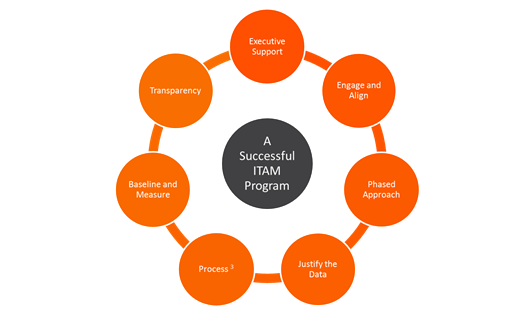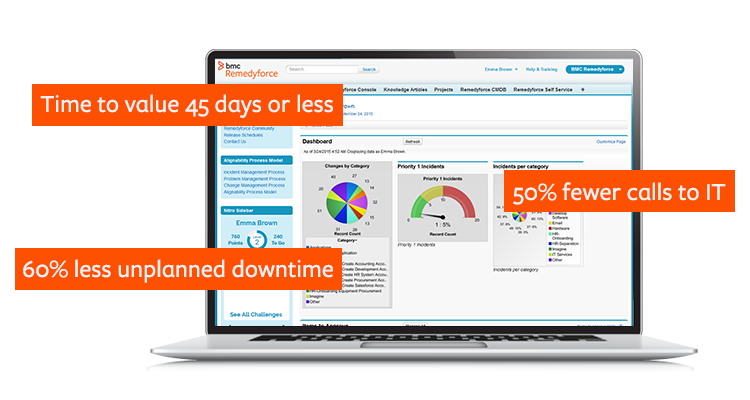Over the years, I’ve worked with many organizations at various states of maturity and success with their IT Asset Management (ITAM) programs. In this blog, I will share with you the seven common practices that I’ve observed from organizations who have built and maintained successful ITAM 
- “Give Them What They Want” (Executive Support/Alignment) – IT Asset Management can be very political because it requires that multiple groups work together with some level of alignment to achieve common ends and produce mutual value. An ITAM program cannot be successful in isolation. Executive support is essential to influence the team
s to gain alignment, share information and work towards a common goal. Without executive support, there is little chance an organization will be able to establish and maintain a successful ITAM program. Depending on the initial scope and approach, teams can experience some minor success upfront without executive support, but it will fade fast as the scope of the full ITAM program increases in subsequent phases, exposing the lack of alignment across the teams. Ideally, with executive support you will have “executive sponsor” to not only support and influence behavior, but sometimes serve as the mediator if any conflict arises. I’ve seen cases where there was limited executive support and direct involvement that negatively impacted the ITAM program resulting in delays. - “What’s in it for me?” (Engage and Align) – Because of the cross functional dependency, a successful ITAM program requires alignment across the teams which may vary depending how your company is organized (ex. IT/Support, Finance, Legal, etc…). Alignment is required on several fronts including the definition of asset management, goals, processes, policies, outcomes, etc… You must weave the needs of your executive sponsor into the aligned plans, but you must also ensure everyone involved receives benefits for their efforts. I have seen organizations who take the initiative to form a cross-functional team and/or steering team/committee experience improved alignment and success.
- “Don’t Boil the Ocean” (Take a Phased Approach) – Another key to establishing and maintaining a successful ITAM program is getting the momentum going with an approach that ensures early success and iterative additional delivered value. To ensure success early in the program, you must make sure you don’t boil the ocean. You must test the waters with a limited scope to “work out the kinks” across people, processes and technologies. This critical success factor is tied into all the other factors. In terms of executive support, you must ensure your scope aligns to the executive’s needs in some way (ex. reducing costs, mitigating risk) and within the executive’s needs, you should focus on a subset of attainable goals for each phase. For example, you may know that the majority of hardware costs come from one or a few asset classes (ex. servers and laptops). Focus on these classes before expanding to others. This will enable you to work out the kinks and give you a higher likelihood of momentum-building success. These gains will breed further success as other teams share in the benefits. You want to think strategically, but implement tactically. In other words, develop a long term plan, but be tactical in your delivery to ensure iterative goal attainment in order to continue onto the next phase/scope. The BMC Remedyforce Onboarding Team has developed an agile-hybrid implementation methodology to deliver quick value.
- “Quality In, Quality Out” (Justify the Data) – Only capture and manage data which is justified. I’ve seen organizations capture a tremendous amount of data because they can. This is made possible through a vast array of discovery tools and/or other systems. The questions you need to ask for every “object” and field is “what” and “why.” If there is value and the effort to capture, maintain and manage the data to ensure accuracy is justified, then include it. Many organizations will define a pricing threshold to clearly define types of records (ex. high monitors over $500). The other dimension here is data quality. The old adage is “garbage in, garbage out”. You must ensure the data source is accurate and the integrations, processes, and people are in place to maintain the data. This also ties back to the phased approach and class types. Don’t manage a class just because it can be discovered. Just because you can doesn’t mean you should.
- “Technology is Not the Only Answer” (Process, Process, Process) – When speaking to organizations about ITAM, especially those who are just beginning to build a program, I commonly state that “ITAM is 80% process, 20% technology.” I make this statement not to downplay the significance of the technologies, but to stress that process is essential for a successful ITAM program, and tools should not be the primary focus. Organizations must also ensure their processes and policies are well defined, communicated and enforced.
- “Rinse and Repeat” (Baseline and Measure) – I’ve seen many organizations focus on most of these other critical success factors, but ignore or not spend as much effort on baselining and measuring; however, they are critical to success. Baselining is important because you must know where you started. How do you know where to go when you don’t know where you are? Organizations must use baselines to track their progress. These can be qualitative, but must also be quantitative. There are several frameworks to leverage including Gartner’s high-level ITAM Maturity Model. The International Association of Information Technology Asset Managers (IAITAM) also has a very good tool called ITAM 360 Assessment Model which provides a more detailed assessment covering 12 key process areas (Note: For those not familiar with IAITAM, I encourage you to take a look at this organization. They have a lot of great real world, practical content and educational material).
Once you baseline, you must measure your progress on a consistent basis. The ongoing measurement and comparison enables organizations to track progress and expose opportunities for improvement. The principles around continuous process improvement are key here. The continuous measurement and assessment of progress exposes strengths and weaknesses, helping identify the opportunities to take your program to the next level.
- “Be Transparent” (Share the Results) – Once you measure, it’s important to share results with executive management and the other teams sponsoring and supporting the program. This is one of the most critical aspects, especially when early in establishing the program. With the right alignment and focused scope, you significantly increase your chances of successful if you communicate those quick (and iterative) wins early and often. Shout your success from the rooftops and you’ll attract other interested parties that you can draw on for support and help you expand the scope and success of your ITAM project.
In summary, all seven factors are essential to build and maintain a successful ITAM program. Over the years, I have seen organizations focus on a few of these factors and initially deliver some level of success, but as they mature, expand scope, and require other teams to get involved, the climb becomes more difficult and they falter. Once you lose momentum, it’s is much harder to get back on track. If you consider and balance each of these critical success factors, you will have a much higher likelihood for success.
The call to action is to insert (for those planning) or assess (for those already with asset management activities) these seven critical success factors. Then continuously measure and evaluate to become a champion within your organization. For those looking for assistance, the BMC Remedyforce Onboarding Team has developed an agile-hybrid methodology that helps organizations get quick value with their ITAM activities. BMC Remedyforce also has certified implementation partners that can assist you as well.
About BMC and BMC Remedyforce
BMC is a global leader in software solutions that help IT transform traditional businesses into digital enterprises for the ultimate competitive advantage. Our Digital Enterprise Management set of IT solutions is designed to make digital business fast, seamless, and optimized. From mainframe to mobile to cloud and beyond, we pair high-speed digital innovation with robust IT industrialization—allowing our customers to provide intuitive user experiences with optimized performance, cost, compliance, and productivity. BMC solutions serve more than 15,000 customers worldwide including 92 of the Forbes Global 100.
BMC Remedyforce is built on the Salesforce Force.com platform—the world’s most widely used cloud platform—to deliver high-speed IT and business service management. Intuitive and powerful, Remedyforce enables enterprises to deliver innovative digital services that accelerate business success and drive increased customer satisfaction. Leveraging industry-leading ITSM tools and practices as well as robust cloud functionality, Remedyforce frees IT and business units to provide faster service support at a much lower cost. Remedyforce delivers a modern, consumerized experience that empowers users and accelerates the business.
To learn about BMC Remedyforce and the innovative Service and Asset Management capabilities, check out our web site which contains a wealth of information including videos, personalized automated demos, whitepapers, customer testimonials and self-guided trials.






